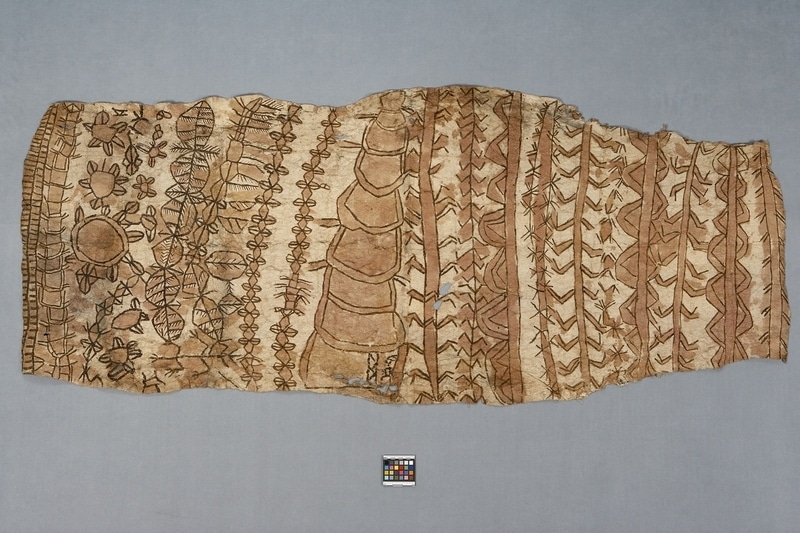Tapa Cloth Item Number: C1280 from the MOA: University of British Columbia


Description
The cloth is natural in colour with designs in dark and light brown. In the centre of the cloth there is a thick brown caterpillar-like figure with many rounded sections, increasing in size across the width of the cloth. There are many lines extending from the sections, much like legs. To one side of the figure, the designs are linear. Thick parallel brown lines have various 'v' patterns attached, some coloured in and some outlined. On the other side of the central figure, the designs are more circular. The parallel brown lines are fewer and have leaf-like patterns attached. In one area there are no lines, but many circles with leaves extending in all directions. The cloth is painted on one side but some paint has bled through to the backside.
History Of Use
Barkcloth, commonly known as tapa, is one of the most distinctive products of the diverse cultures of the Pacific Islands. The name is derived from the Samoan word tapa, which means the undecorated edge of a piece of barkcloth, and the Hawaiian word kapa, a variety of barkcloth. Tapa was probably brought to the Pacific Islands thousands of years ago by the ancestors. No important occasion is complete without the presence of tapa, and those who make it continue to generate techniques and designs that serve both utilitarian and ceremonial purposes.
Item History
- Made in Erromango, Tafea, Vanuatu before 1960
- Owned by Union College before 1960
- Received from Union College (Donor) during 1960
What
- Name
- Tapa Cloth
- Identification Number
- C1280
- Type of Item
- tapa cloth
- Material
- paper mulberry bark, paint and pigment
- Manufacturing Technique
- pounded
- Overall
- height 205.0 cm, width 87.0 cm
Who
- Culture
- Ni-Vanuatu
- Previous Owner
- Union College
- Received from
- Union College (Donor)
Where
- Holding Institution
- MOA: University of British Columbia
- Made in
- Erromango, Tafea, Vanuatu
When
- Creation Date
- before 1960
- Ownership Date
- before 1960
- Acquisition Date
- during 1960
Other
- Item Classes
- textiles
- Condition
- good
- Current Location
- Case 60
- Accession Number
- 1812/0003